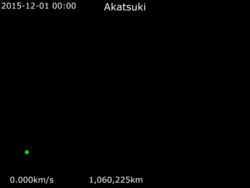Astronomy:Cytherocentric orbit
A Cytherocentric orbit is an orbit around the planet Venus. Venus has no moon, but several man-made objects orbit the planet.
The name is analogous to the term "geocentric orbit" for an orbit around Earth and "heliocentric orbit" for an orbit around the Sun. The apsides of an Cytherocentric orbit are pericytherion, the pericenter (analogous to "perigee"), and the apocenter is named apocytherion (analogous to "apogee").
Etymology
The Cythero prefix is derived from Kythira or "Cythera." In Greek mythology, Cythera was an island associated with the goddess Aphrodite, who is the equivalent of the Roman goddess Venus. Therefore, naming an orbit around Venus "cytherocentric" is a way of referencing Venus' association with this goddess.[citation needed]
Satellites in Cytherocentric orbit
Venera 9 was the first satellite to achieve Venus orbit in 20 October 1975. Akatsuki was the latest probe to achieve Venus orbit in 2015.[1]
Eight probes have achieved Venus orbit:
- 4 Soviet Union probes, Venera 9, Venera 10, Venera 15, Venera 16
- Two NASA probe, Magellan, Pioneer Venus 1
- One JAXA probe, Akatsuki
- One ESA probe, Venus Express.
In order to enter Venus orbit, a satellite has to perform an engine burn to reduce the speed. Otherwise, the probe moves too fast to achieve orbit and will be a flyby. A noteworthy case is that of Japanese probe Akatsuki, which failed to enter orbit around Venus on 6 December 2010.[2] JAXA stated on 8 December that the probe's orbital insertion maneuver had failed,[3] because of a defect in the orbital insertion burn. After the craft orbited the Sun for five years, engineers successfully placed it into an alternative Venusian elliptic orbit on 7 December 2015 by firing its attitude control thrusters for 20 minutes.
Magellan was the first interplanetary probe to use aerobraking to reduce the apocytherion. [4] By passing through the dense atmosphere, a probe can reduce its speed and attain the necessary delta-v. Venus's thick atmosphere supports aerobraking. This reduces fuel needs.
Stationary and synchronous orbits
A satellite with revolutionary period that matches the planet's rotational period appears fixed at a position in the sky relative to an observer on the planet. Such an orbit on Earth is a Geostationary orbit. [5]
The height of a stationary or synchronous orbit can be calculated as follows:
- [math]\displaystyle{ R_{syn} = \sqrt[3]{{G(m_2)T^2\over 4 \pi^2}} }[/math][6]
where G is the gravitational constant , m2 is the mass of the celestial body, and T is the sidereal rotational period of the body.
By this formula one can find the geostationary-analogous cytherostationary orbit. Around Venus, such an orbit would be 1,536,600 km or about 253 Venus radii from the planet's surface. This is because Venus has the slowest rotation rate of any planet. The slower the rotation, the farther away a satellite must be in order to be stationary. The hill sphere of a celestial body describes the region in which the gravity of that body is dominant. The hill sphere radius of Venus is about 1 million kilometers; and as the cytherostationary orbital distance lies outside of it, no stable cytherostationary satellite can exist.
See also
References
- ↑ "Exploration: Venus". The National Aeronautics and Space Administration. 2010. https://science.nasa.gov/venus/exploration/.
- ↑ JAXA's press briefing, 22:00, 7 December 2010 JST
- ↑ "Japan's Venus Probe Fails to Enter Orbit". ABC News. https://abcnews.go.com/Technology/wireStory?id=12339589.
- ↑ Lyons, Daniel T.; Saunders, R. Stephen; Griffith, Douglas G. (1 May 1995). "The Magellan Venus mapping mission: Aerobraking operations" (in en). Acta Astronautica 35 (9): 669–676. doi:10.1016/0094-5765(95)00032-U. ISSN 0094-5765. Bibcode: 1995AcAau..35..669L. https://www.sciencedirect.com/science/article/abs/pii/009457659500032U.
- ↑ "Space Today Online - Answers To Your Questions". Spacetoday.org. 2010. http://www.spacetoday.org/Questions/PolarSats.html.
- ↑ "Calculating the Radius of a Geostationary Orbit - Ask Will Online" (in en-GB). Ask Will Online. 2012-12-27. https://www.askwillonline.com/2012/12/calculating-radius-of-geostationary.html.
 |


